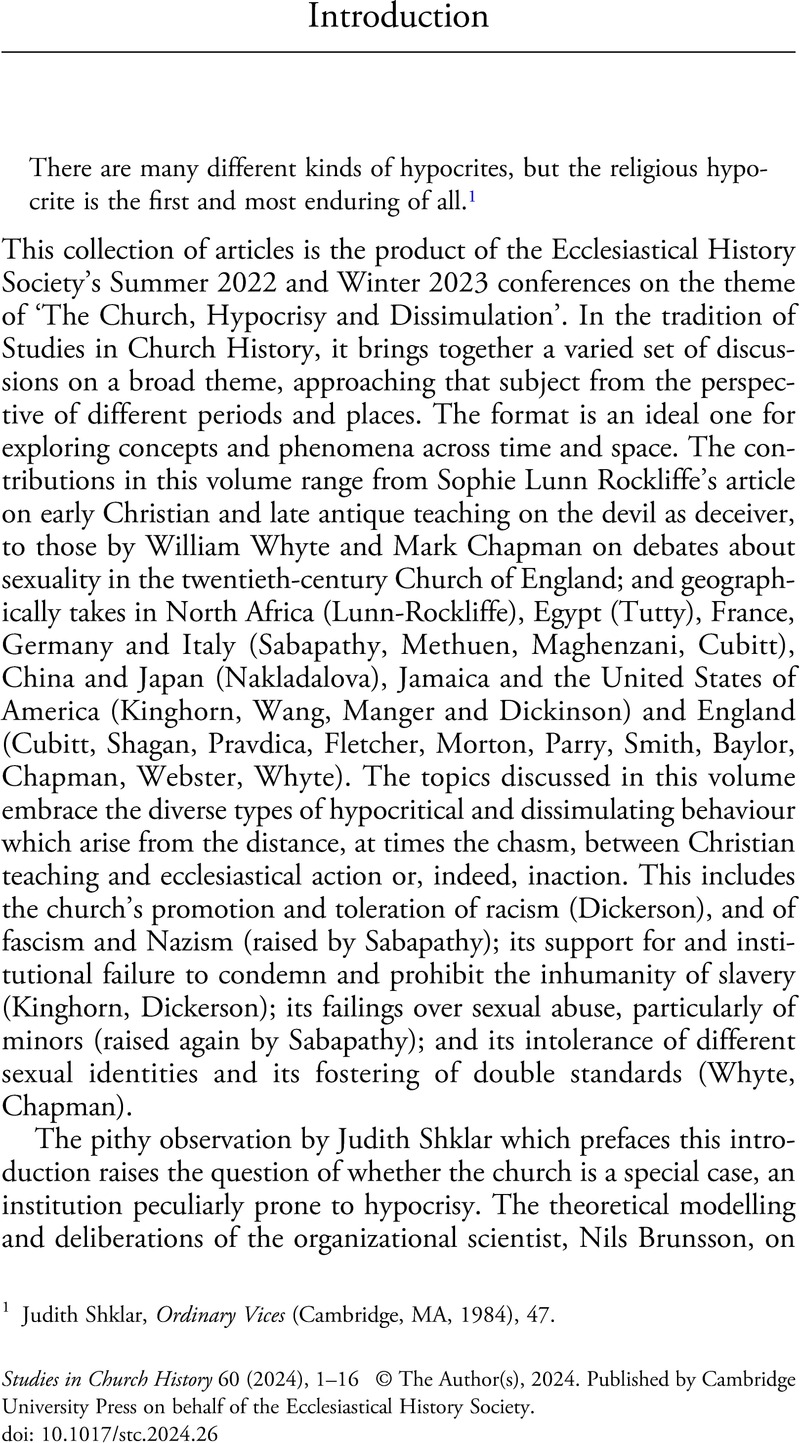No CrossRef data available.
Article contents
Abstract

Information
- Type
- Introduction
- Information
- Studies in Church History , Volume 60: THE CHURCH, HYPOCRISY AND DISSIMULATION , June 2024 , pp. 1 - 16
- Copyright
- Copyright © The Author(s), 2024. Published by Cambridge University Press on behalf of the Ecclesiastical History Society
References
1 Shklar, Judith, Ordinary Vices (Cambridge, MA, 1984), 47Google Scholar.
2 Brunsson, Nils, ‘Organized Hypocrisy’, in idem, The Consequences of Decision-Making (Oxford, 2007), 111–34Google Scholar, at 114.
3 Shklar, Ordinary Vices, 45–86. See also the article by John Sabapathy in this volume.
4 Shklar, Ordinary Vices, 86.
5 Runciman, David, Political Hypocrisy: The Mask of Power from Hobbes to Orwell and Beyond (Princeton, NJ, 2008)Google Scholar; Thompson, Dennis F., Restoring Responsibility Ethics in Government, Business and Healthcare (Cambridge, 2004), 209–26CrossRefGoogle Scholar; Brunsson, ‘Organized Hypocrisy’.
6 Runciman, Political Hypocrisy, 9.
7 Griffiths, Paul J., Lying: An Augustinian Theology of Duplicity (Grand Rapids, MI, 2004)Google Scholar.
8 On this, see Zagorin, Perez, Ways of Lying: Dissimulation, Persecution, and Conformity in Early Modern Europe (Cambridge, MA, 1990), 15–20CrossRefGoogle Scholar; Amory, Frederic, ‘Whited Sepulchres: The Semantic History of Hypocrisy to the High Middle Ages’, Recherches de théologie ancienne et médiévale 53 (1986), 5–39CrossRefGoogle Scholar.
9 See the article by Sophie Lunn-Rockliffe in this volume.
10 See the article by David Parry in this volume for a Dissenting critique of the hypocrisy induced by persecution and forced religious conformity. Compare also Zagorin, Ways of Lying; and Diarmaid MacCulloch, Silence: A Christian History (London, 2013), 163–84.
11 See the article by Simone Maghenzani in this volume.
12 See the article by Christy Wang in this volume.
13 See the article by David Fletcher in this volume.
14 See the article by Ethan Shagan in this volume on the parson's excuse for kneeling.
15 See the article by William Whyte in this volume.
16 Ryrie, Alec, Being Protestant in Reformation Britain (Oxford, 2013), 27–62, 104–5, 461–2CrossRefGoogle Scholar. See also Dorsey, Andy, ‘A Rhetoric of American Experience: Thomas Shepard's Cambridge Confessions and the Discourse of Spiritual Hypocrisy’, Early American Literature 49 (2014), 629–62CrossRefGoogle Scholar.
17 See the article by Catherine Cubitt in this volume.
18 See the article by Mark Smith in this volume.
19 See also Trilling, Lionel, Sincerity and Authenticity (Cambridge, MA, 1971)Google Scholar; Parry, David, ‘“A Divine Kind of Rhetoric”: Rhetorical Strategy and Spirit-Wrought Sincerity in English Puritan Writing’, Christianity and Literature 67 (2017), 113–38CrossRefGoogle Scholar.
20 See, for example, Zagorin, Ways of Lying; Trilling, Sincerity and Authenticity; Miriam Eliav-Feldon and Tamar Herzog, eds, Dissimulation and Deceit in Early Modern Europe (Basingstoke, 2015).
21 For earlier manifestations of hypocrisy and anticlericalism and antifraternalism, see the articles by Sabapathy and Konstantinos Gravanis in this volume.
22 See the article by Fletcher in this volume.
23 Shklar, Ordinary Vices, 48.
24 See the article by Edward G. Manger in this volume.
25 See the article by Shagan in this volume.
26 Shklar, Ordinary Vices, 62.
27 Eliav-Feldon and Herzog, eds, Dissimulation and Deceit.
28 This is highlighted by Ethan Shagan, Anna Pravdica and Adam Morton in this volume.
29 See the article by Sabapathy in this volume; Sita Steckel, ‘Hypocrites! Critiques of Religious Movements and Criticism of the Church, 1050–1300’, in Jennifer Kolpacoff Deane and Anne E. Lester, eds, Between Orders and Heresy (Toronto, 2022), 79–126, at 108–11; Courtney Booker, ‘Hypocrisy, Performativity, and the Carolingian Pursuit of Truth’, Early Medieval Europe 26 (2018), 174–202. See also Nicholas Watson, ‘Whited Sepulchres: Towards a History of Hypocrisy, 1100–1400’, unpublished paper to the Medieval Academy (2010), which highlights the emergence of hypocrisy as a public vice in the thirteenth century. I am very grateful to Professor Watson for sharing this with me. Compare Amory, ‘Whited Sepulchres: The Semantic History’, 5–39.
30 Steckel, ‘Hypocrites!’, 79–126.
31 Watson, ‘Whited Sepulchres’.
32 See, for example, Catherine Cubitt, Sin and Society (Cambridge, forthcoming).
33 MacCulloch, Silence, 184–90.
A correction has been issued for this article:
Linked content
Please note a has been issued for this article.


